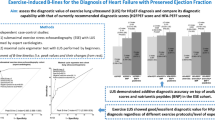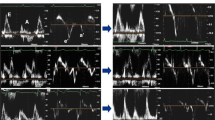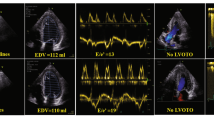Abstract
Current guidelines recommend the use of exercise stress echocardiography (ESE) in patients with unexplained dyspnoea. SE was recently reshaped with the ABCDE protocol: A for asynergy, B for B-lines (4-site simplified scan), C for contractile reserve based on force, D for Doppler-based coronary flow velocity reserve (CFVR) in left anterior descending coronary artery; and E for EKG-based heart rate reserve (HRR, defined as peak/rest HR < 1.62). Aim of the study was to define the ESE response in patients with dyspnoea as the main symptom. From the initial population of patients referred in 2018 in a single center for semi-supine ESE, we selected two groups (without history of previous myocardial infarction or coronary revascularization) on the basis of the main presenting symptom: dyspnoea (Group 1, n = 100, 62 men, 63 ± 10 years) or chest pain (Group 2, n = 100, 58 men, age 61 ± 8 years). All underwent ESE with ABCDE protocol. Success rate was 100% for steps A, B, C, E, and 88% for step D. Positivity for A criterion occurred in 56 patients of Group 1 and 24 of Group 2 (p < 0.0001). B-lines positivity (stress > rest for ≥ 2 points) occurred in 40 patients of Group 1 and 28 of Group 2 (p = 0.07). LVCR positivity (< 2.0) occurred in 60 patients of Group 1 and 42 of Group 2 (p < 0.05). A reduced CFVR occurred in 56 of Group 1 and 22 of Group 2 (p < 0.0001). A blunted HRR was present in 44 patients of Group 1 and 22 of Group 2 (p < 0.001). In conclusion, in patients with unexplained dyspnoea, SE with ABCDE protocol is useful to document the cardiac origin of dyspnoea with a comprehensive assessment focused not only on ischemia (A) but also pulmonary congestion (B), myocardial scar or necrosis (C), coronary microvascular dysfunction (D) or chronotropic incompetence (E).




Similar content being viewed by others
Abbreviations
- CAD:
-
Coronary artery disease
- CFVR:
-
Coronary flow velocity reserve
- CV:
-
Coefficient of variation
- EF:
-
Ejection fraction
- ESE:
-
Exercise stress echocardiography
- ESV:
-
End-systolic volume
- HRR:
-
Heart rate reserve
- LV:
-
Left ventricle
- LVCR:
-
Left ventricular contractile reserve
- RWMA:
-
Regional wall motion abnormalities
- SE:
-
Stress echocardiography
- TTE:
-
Transthoracic echocardiography
- WMSI:
-
Wall motion score index
References
Lancellotti P, Pellikka PA, Budts W, Chaudry F, Donal E, Dulgheru R, Edvarsen T, Garbi M, Ha JW, Kane G, Kreeger J, Mertens L, Pibarot P, Picano E, Ryan T, Tsutsui J, Varga A (2016) Recommendations for the clinical use of stress echocardiography in non-ischemic heart disease: joint document of the European Association of Cardiovascular imaging and the American Society of Echocardiography. Eur Heart J Cardiovasc Imaging 17:1191–1222
Knuuti J, Wijns W, Saraste A et al (2019) The task force for the diagnosis and management of chronic coronary syndromes of the European Society of cardiology. Eur Heart J 00:1–71
Brubaker PH, Kitzman DW (2011) Chronotropic incompetence. Causes, consequences and management. Circulation 123:1010–1020
Picano E, Ciampi Q, Wierzbowska-Drabik K, Urluescu ML, Morrone D, Carpeggiani C (2018) The new clinical standard of integrated quadruple stress echocardiography with ABCD protocol. Cardiovasc Ultrasound 16:22
Ciampi Q, Zagatina A, Cortigiani L, on behalf of Stress echo 2020 study group et al (2019) Functional, coronary anatomic and prognostic correlates of coronary flow velocity reserve during stress echocardiography. JACC 74:2280–2293
Lauer MS, Okin PM, Larson MG, Evans JC, Levy D (1996) Impaired heart rate response to graded exercise. Prognostic implications of chronotropic incompetence in the Framingham Heart Study. Circulation 93:1520–1526
Picano E, Ciampi Q, Citro R, D'Andrea A, Scali MC, Cortigiani L, Olivotto I, Mori F, Galderisi M, Costantino MF, Pratali L, Di Salvo G, Bossone E, Ferrara F, Gargani L, Rigo F, Gaibazzi N, Limongelli G, Pacileo G, Andreassi MG, Pinamonti B, Massa L, Torres MAR, Miglioranza MH, Daros CB, de Castro e Silva Pretto JL, Beleslin B, Djordjevic-Dikic A, Varga A, Palinkas A, Agoston G, Gregori D, Trambaiolo P, Severino S, Arystan A, Paterni M, Carpeggiani C, Colonna P (2017) Stress echo 2020: the international Stress Echo study in ischemic and non-ischemic heart disease. Cardiovasc Ultrasound 15:3
Ciampi Q, Picano E, Paterni M, Borguezan Daros C, Simova I, de Castro e Silva Pretto JL, Scali MC, Gaibazzi N, Severino S, Djordjevic-Dikic A, Kasprzak J, Zagatina A, Varga A, Lowenstein J, Merlo PM, Amor M, Celeutkiene J, Perez J, Di Salvo G, Galderisi M, Mori F, Costantino FM, Massa L, Dekleva M, Quesada Chavez D, Trambaiolo P, Citro R, Colonna P, Rigo F, Torres ARM, Monte I, Stankovic I, Neskovic A, Cortigiani L, Re F, Dodi C, D'Andrea A, Villari B, Arystan A, De Nes M, Carpeggiani C, on behalf of Stress Echo 2020 study group of the Italian Society of Cardiovascular Echography (2017) Quality control of regional wall motion analysis in stress echo 2020. Int J Cardiol 249:479–485
Lang RM, Badano LP, Mor-Avi V, Afilalo J, Armstrong A, Ernande L, Flachskampf FA, Foster E, Goldstein SA, Kuznetsova T, Lancellotti P, Muraru D, Picard MH, Rietzschel ER, Rudsli L, Spencer KT, Tsang W, Voigt JU (2015) Recommendations for cardiac chamber quantitation by echocardiography: an update from the American Society of Echocardiography and the European Association of Cardiovascular Imaging. J Am Soc Echocardiogr 28:1–39
Sicari R, Nihoyannopoulos P, Evangelista A, Kasprzak J, Lancellotti P, Poldermans D, Voigt JU, Zamorano JL, on behalf of the European Association of Echocardiography (2008) Stress echocardiography expert consensus statement. European Association of Echocardiography (EAE) (a registered branch of the ESC). Eur J Echocardiogr 9:415–437
Pellikka PA, Nagueh SF, Elhendy AA, Kuehl CA, Sawada SG (2007) American Society of Echocardiography recommendations for performance, interpretation, and application of stress echocardiography. J Am Soc Echocardiogr 20:1021–1024
Scali MC, Zagatina A, Simova I, Zhuravskaya N, Ciampi Q, Paterni M, Marzilli M, Carpeggiani C, Picano E (2017) B-lines with lung ultrasound: the optimal scan technique at rest and during stress. Ultrasound Med Biol 43:2558–2563
Cortigiani L, Huqi A, Ciampi Q, Bombardini T, Bovenzi F, Picano E (2018) Integration of wall motion, coronary flow velocity, and left ventricular contractile reserve in a single test: prognostic value of vasodilator stress echocardiography in patients with diabetes. J Am Soc Echocardiogr 31:692–701
Zagatina A, Zhuravskaya N (2017) The additive prognostic value of coronary flow velocity reserve during exercise echocardiography. Eur Heart J Cardiovasc Imaging 18:1179–1184
Khan MN, Pothier CE, Lauer ME (2005) Chronotropic incompetence as a predictor of death among patients with normal electrocardiogram taking beta-blockers (metoprolol or atenolol). Am J Cardiol 96:1328–1333
Scali MC, Ciampi Q, Picano E, Bossone E, Ferrara F, Citro R et al (2018) Quality control of B-lines analysis in Stress Echo 2020. Cardiovasc Ultrasound 16:20
Scali MC, Cortigiani L, Simionuc A, Gregori D, Marzilli M, Picano E (2017) Exercise-induced B-lines identify worse functional and prognostic stage in heart failure patients with depressed left ventricular function. Eur J Heart Fail 19:1468–1478
Picano E, Scali MC, Ciampi Q, Lichtenstein D (2018) Lung ultrasound for the cardiologist. J Am Coll Cardiol Cardiovasc Imaging 12:381–390
Shah SJ, Lam CSP, Svedlund S, Saraste A, Hage C, Tan R-S, Beussink-Nelson L, Faxen UL, Fermer ML, Broberg MA, Gan LM, Lund LH (2018) Prevalence and correlates of coronary microvascular dysfunction in heart failure with preserved ejection fraction. PROMIS-HFpEF. Eur Heart J 39:3439–3450
Elhendy A, Mahoney DH, Khanderia BK, Burger K, Pellikka PA (2003) Prognostic significance of impairment of heart rate response to exercise: impact of left ventricular function and myocardial ischemia. J Am Coll Cardiol 42:823–830
Balaravi B, Miller TD, Hodge DO, Gibson RJ (2006) The value of stress single photon emission tomography in patients without known coronary artery disease presenting with dyspnoea. Am Heart J 152:551–557
Nakanishi R, Rana JS, Rozanski A et al (2013) Relationship of dyspnoea vs. typical angina to coronary artery disease severity, burden, composition and location on coronary CT angiography. Atherosclerosis 230:61–66
Scali MC, Zagatina A, Ciampi Q, Cortigiani L, Andrea A, Djordjevic-Dikic A, Merlo PM, Lattanzi F, Simova I, Monte I, Dodi C, Kasprzak JD, Galderisi M, Boshchenko A, Rigo F, Varga A, Dekleva M, Re F, de Castro e Silva Pretto JL, Zhuravskaya N, Coviello K, Citro R, Colonna P, Wierzbowska-Drabik K, Carpeggiani C, Picano E, Stress Echo 2020 study group of the Italian Society of Echocardiography, and Cardiovascular Imaging (SIECVI) (2019) The functional meaning of B-profile during stress lung ultrasound. Research letter. JACC Cardiovasc Imaging 12:928–930
Chaowalit N, Mc Cully RB, Callahan MJ, Mookadam F, Bailey KM, Pellikka PA (2006) Outcomes after normal dobutamine stress echocardiography and predictors of adverse events: long-term follow-up of 3014 patients. Eur Heart J 27:3039–3044
Cortigiani L, Carpeggiani C, Landi P, Raciti M, Bovenzi F, Picano E (2019) Usefulness of blunted heart rate reserve as an imaging-independent prognostic predictor during dipyridamole-echocardiography test. Am J Cardiol. https://doi.org/10.1015/j.amjcard.2019.06.017
Pieske B, Tschope C, De Boer RA et al (2019) How to diagnose heart failure with preserved ejection fraction. The HFA-PEFF prognostic algorithm: a consensus recommendation from the Heart Failure Association (HFA) of the European Association of Cardiology (ESC). Eur Heart J 40:3297–3317
Mulvagh SL, Mokhtar AT (2019) Coronary flow velocity reserve in stress echocardiography. Time to go with the normal flow? Editorial comment. J Am Coll Cardiol 74:2292–2294
Fuster V (2019) Podcast. Editorial audio summary. JACC 74:2280–2293
Funding
None.
Author information
Authors and Affiliations
Consortia
Contributions
AZ had the original idea and drafted the manuscript; AZ, NZ recruited all patients, critically revised the manuscript for an intellectually important contribution and approved the submitted version; DS critically revised the manuscript for an intellectually important contribution and approved the submitted version; QC is the principal investigator of SE2020, helped to organize the structure of training, contributed to developing the web-based training, and approved the submitted version; CC is responsible for data quality control and reader' certification, performed the data analysis, and helped to draft the manuscript. EP is the study chairman, designed the protocol, organized the content of web-based training, contributed to data analysis and contributed to draft the manuscript.
Corresponding author
Ethics declarations
Conflict of interest
The authors have no conflicts of interest to disclose.
Additional information
Publisher's Note
Springer Nature remains neutral with regard to jurisdictional claims in published maps and institutional affiliations.
A full listing of the members of the Stress Echo 2020 study group can be found at the website http://se2020.altervista.org.
Rights and permissions
About this article
Cite this article
Zagatina, A., Zhuravskaya, N., Shmatov, D. et al. Exercise stress echocardiography with ABCDE protocol in unexplained dyspnoea. Int J Cardiovasc Imaging 36, 823–831 (2020). https://doi.org/10.1007/s10554-020-01789-6
Received:
Accepted:
Published:
Issue Date:
DOI: https://doi.org/10.1007/s10554-020-01789-6




